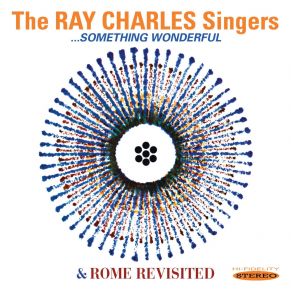Something Wonderful / Rome Revisited
Download links and information about Something Wonderful / Rome Revisited by Ray Charles Singers, The. This album was released in 2014 and it belongs to Jazz, Pop, Smooth Jazz genres. It contains 24 tracks with total duration of 01:16:54 minutes.

|
|
|---|---|
| Artist: | Ray Charles Singers, The |
| Release date: | 2014 |
| Genre: | Jazz, Pop, Smooth Jazz |
| Tracks: | 24 |
| Duration: | 01:16:54 |
| Buy it NOW at: | |
| Buy on iTunes $9.99 | |
| Buy on Amazon $8.99 | |
Tracks
[Edit]| No. | Title | Length |
|---|---|---|
| 1. | Misty | 3:55 |
| 2. | East of the Sun | 3:50 |
| 3. | My Old Flame | 3:31 |
| 4. | Paradise | 3:33 |
| 5. | For All We Know | 3:17 |
| 6. | Soft Lights and Sweet Music | 3:22 |
| 7. | I'm over Here | 3:25 |
| 8. | Don't Blame Me | 3:34 |
| 9. | My Ideal | 2:18 |
| 10. | These Foolish Things | 3:52 |
| 11. | Embraceable You | 2:59 |
| 12. | Goodbye | 3:34 |
| 13. | Vieni, Vieni | 2:10 |
| 14. | Tell Me That You Love Me | 3:00 |
| 15. | Volare | 3:15 |
| 16. | Non Dimenticar | 3:28 |
| 17. | Traveling Down a Lonely Road | 3:17 |
| 18. | Ferryboat Serenade (Funiculi-Funicula) | 2:11 |
| 19. | Nina | 2:26 |
| 20. | No Voce, Na Chittara, E'o Poco 'E Luna | 3:06 |
| 21. | The Woodpecker Song | 2:20 |
| 22. | Summertime in Venice | 4:01 |
| 23. | Santa Lucia | 2:57 |
| 24. | Arrivederci, Roma | 3:33 |
Details
[Edit]First off, the Ray Charles of the Ray Charles Singers isn't the "Georgia on My Mind" Ray Charles. It's the professional name of Charles Raymond Offenberg, a traditional pop composer, arranger, and bandleader, the "Other Ray Charles," as he was often referred to, who also worked with artists like Julie Andrews, Bob Hope, and Frank Sinatra, was a music consultant on The Muppet Show, and sang the theme song for the television sitcom Three's Company, among other accomplishments. He also released several albums of lushly orchestrated easy listening versions of various pop standards under the name the Ray Charles Singers in the 1960s on Enoch Light's Command Records (originally Command Performance Records) imprint, including the two combined here, 1961's Something Wonderful and 1962's Rome Revisited. Light, who also released albums under his own name that were similar to what Charles was producing, aimed his releases at audiophiles, recording them onto 35mm film rather than magnetic tape, which allowed him to create multi-track recordings that gave more control over each track's mix and istereo positioning, among other innovations. The quality of the sound for the time era of these releases is what gives them a certain archival and historical interest, but the music itself, and the vocal arrangements, reduce most songs to the level of pleasant wallpaper.